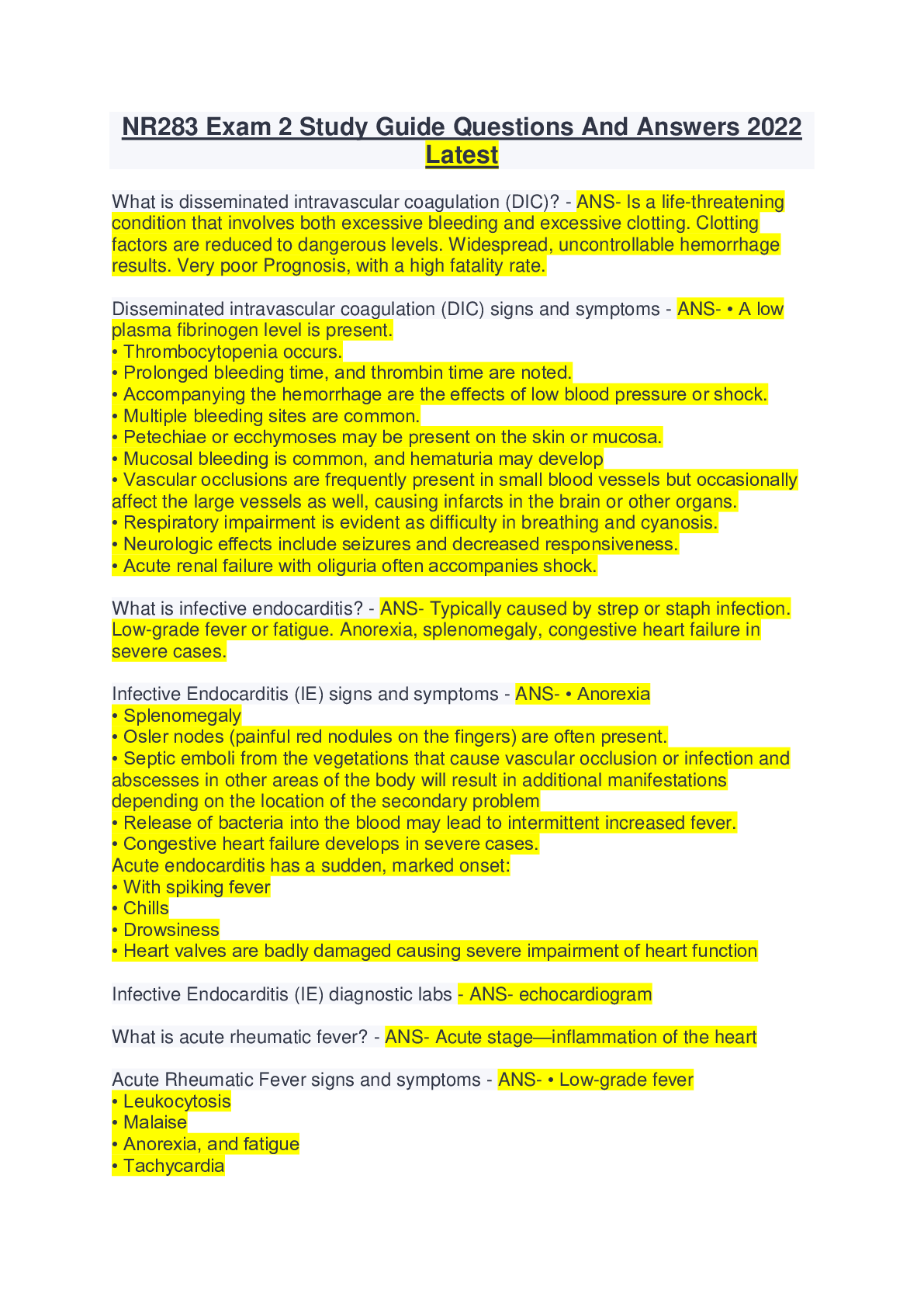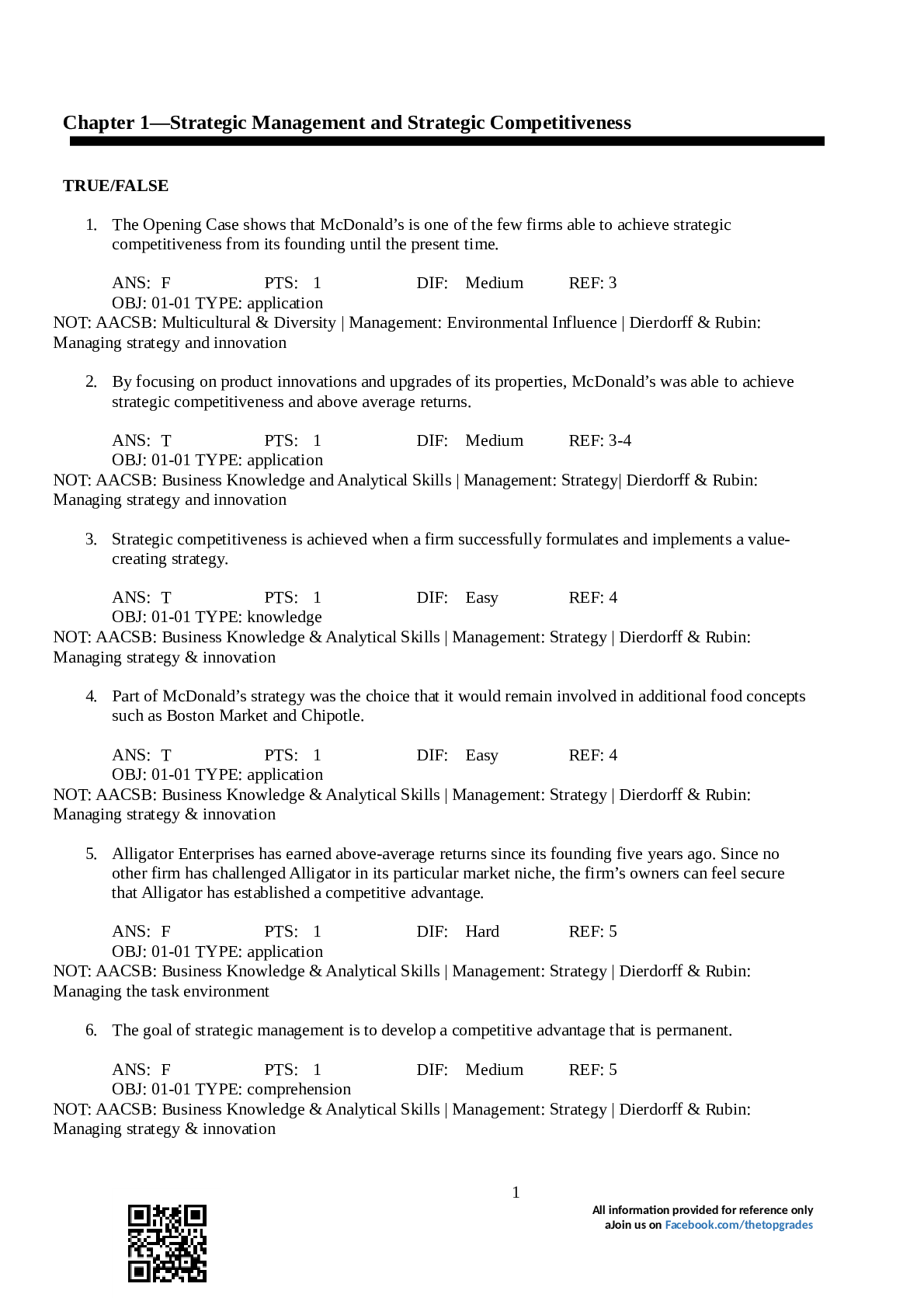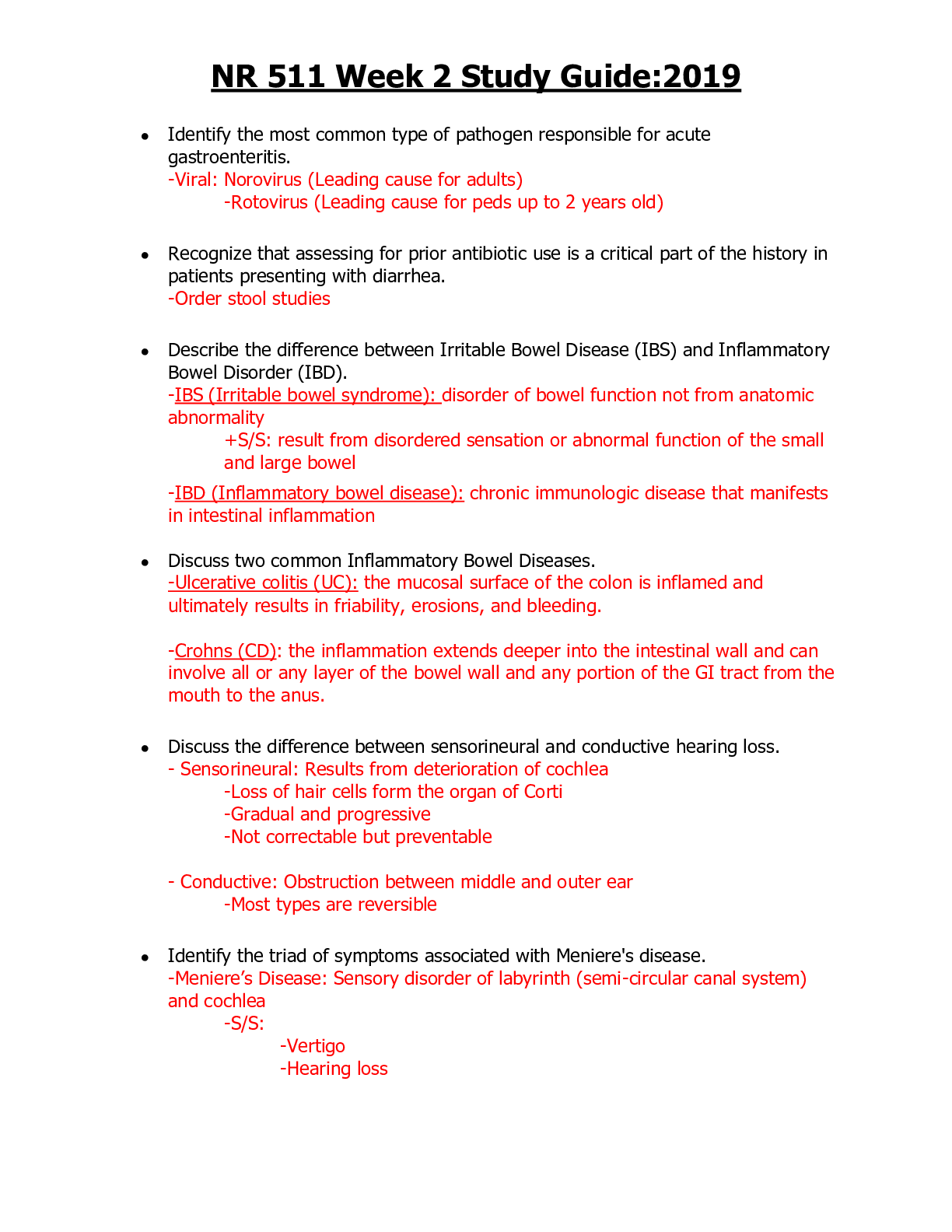NR283 Exam 2 Study Guide Questions And Answers 2022 Latest
Document Content and Description Below
NR283 Exam 2 Study Guide Questions And Answers 2022 Latest What is disseminated intravascular coagulation (DIC)? - ANS- Is a life-threatening condition that involves both excessive bleeding and e... xcessive clotting. Clotting factors are reduced to dangerous levels. Widespread, uncontrollable hemorrhage results. Very poor Prognosis, with a high fatality rate. Disseminated intravascular coagulation (DIC) signs and symptoms - ANS- • A low plasma fibrinogen level is present. • Thrombocytopenia occurs. • Prolonged bleeding time, and thrombin time are noted. • Accompanying the hemorrhage are the effects of low blood pressure or shock. • Multiple bleeding sites are common. • Petechiae or ecchymoses may be present on the skin or mucosa. • Mucosal bleeding is common, and hematuria may develop • Vascular occlusions are frequently present in small blood vessels but occasionally affect the large vessels as well, causing infarcts in the brain or other organs. • Respiratory impairment is evident as difficulty in breathing and cyanosis. • Neurologic effects include seizures and decreased responsiveness. • Acute renal failure with oliguria often accompanies shock. What is infective endocarditis? - ANS- Typically caused by strep or staph infection. Low-grade fever or fatigue. Anorexia, splenomegaly, congestive heart failure in severe cases. Infective Endocarditis (IE) signs and symptoms - ANS- • Anorexia • Splenomegaly • Osler nodes (painful red nodules on the fingers) are often present. • Septic emboli from the vegetations that cause vascular occlusion or infection and abscesses in other areas of the body will result in additional manifestations depending on the location of the secondary problem • Release of bacteria into the blood may lead to intermittent increased fever. • Congestive heart failure develops in severe cases. Acute endocarditis has a sudden, marked onset: • With spiking fever • Chills • Drowsiness • Heart valves are badly damaged causing severe impairment of heart function Infective Endocarditis (IE) diagnostic labs - ANS- echocardiogram What is acute rheumatic fever? - ANS- Acute stage—inflammation of the heart Acute Rheumatic Fever signs and symptoms - ANS- • Low-grade fever • Leukocytosis • Malaise • Anorexia, and fatigue • Tachycardia • Heart murmurs • Epistaxis and abdominal pain may be present Acute Rheumatic Fever treatments - ANS- Antibacterial agents such as penicillin V may be administered to eradicate any residual infection and prevent additional infection. Any future streptococcal infection should be promptly treated. Anti-inflammatory agents such as ASA or corticosteroids (prednisone) may be given. Acute Rheumatic Fever diagnostics labs - ANS- Elevated serum antibody levels remain after the infection has been eradicated. Leukocytosis and anemia are common. Heart function tests, may be required. Characteristic ECG changes develop. What signs and symptoms may be present in a patient with excessive blood loss? - ANS- • Abnormal Pain • Blood in the stool • Black, tarry stool • Blood in the urine • Vomiting blood • Chest Pain • Abdominal Swelling What is pernicious anemia? - ANS- Is a rare blood disorder characterized by the inability of the body to properly utilize vitamin B12, this is essential for the development of red blood cells. Pernicious Anemia signs and symptoms - ANS- • The tongue is typically enlarged, red, sore, and shiny. • The decrease in gastric acid leads to digestive discomfort, often with nausea and diarrhea. • The neurologic effects include tingling or burning sensations in the extremities or loss of muscle control/coordination, referred to as ataxia. • Fatigue • Shortness of breath • Rapid Heart Rate • loss of appetite • Diarrhea Pernicious Anemia treatment - ANS- Vitamin B12 injections Pernicious Anemia diagnostics labs - ANS- • The erythrocytes appear macrocytic or megaloblastic and nucleated on microscopic examination and are reduced in number in the peripheral blood. • The bone marrow is hyperactive, with increased numbers of megaloblasts. Granulocytes are hype segmented and are decreased in number. • The vitamin B12 level in the serum is below normal. In the Schilling test, an oral dose of radioactive vitamin B12 is used to measure absorption. • The presence of hypochlorhydria or achlorhydria confirms the presence of gastric atrophy. What is angina pectoris? - ANS- chest pain when there's a deficit of oxygen to meet myocardial needs and the heart muscle can't function normal Angina Pectoris signs and symptoms - ANS- Burning, squeezing and tightness in the chest; women may have abdominal and back pain; precursor to an MI Angina Pectoris treatment - ANS- • Rest, stop activity • Sit patient down in upright position • Administration of nitroglycerin- sublingual • check pulse and respiration • administer oxygen (if needed) • if patient is known to have angina= give second dose of nitroglycerin • if patient has no history of angina= emergency medical aid Angina Pectoris diagnostic labs - ANS- • Electrocardiogram (ECG) • Stress test w/o imaging or blood tests • Chest X-ray, Chest CT, coronary CT angiography, cardiac MRI, coronary angiography, echocardiogram or stress test w/ imaging What is congestive heart failure? - ANS- heart is unable to pump out sufficient blood to meet metabolic demands of the body Congestive Heart Failure signs and symptoms - ANS- • decreased blood supply to tissues, general hypoxia • fatigue and weakness • dyspnea/ shortness of breath • tachycardia(heart pumps faster) • daytime oliguria(amount of peeing) Congestive Heart Failure treatment - ANS- • eat less salt, limit fluid intake, prescription medication, defibrillator or pacemaker • exercise, weight loss, stop smoking, low sodium diet • cardiac resynchronization therapy • medications(diuretic, Beta blocker, ACE inhibitor, etc) • surgery(coronary artery bypass surgery) Congestive Heart Failure diagnostic labs - ANS- • EKG/ECG/stress test • echocardiogram • CT scan • MRI scan • PET scan • Biopsy or catheterization of the heart and arteries What is pediculosis capitis? - ANS- is a common condition caused by infestation of the hair and scalp by Pediculus humanus capitis (the head lice/louse) Pediculosis Capitis signs and symptoms - ANS- pruritic area, reddened area, swollen (edematous) area, area covered with small vesicles and may be painful Pediculosis Capitis treatment - ANS- removal of the irritant as soon as possible and reduction of the inflammation with topical glucocorticoid Pediculosis Capitis diagnostic labs - ANS- There isn't a test but Patch testing can be helpful in determining if you're allergic to a specific substance What is squamous cell carcinoma? - ANS- is Painless, malignant tumor of the epidermis Squamous Cell Carcinoma signs and symptoms - ANS- development of scaly, slightly elevated, reddish lesion, irregular border around the lesion, central ulceration, and the tumor grows relatively slowly in all directions Squamous Cell Carcinoma treatment - ANS- surgical removal and radiation plus chemotherapy Squamous Cell Carcinoma diagnostic labs - ANS- Skin Exam, Biopsy, Shave Biopsy, Punch Biopsy, Incisional Biopsy, Excisional Biopsy, Computed Tomography (CT) Scan, Magnetic Resonance Imaging (MRI) What is psoriasis? - ANS- Chronic inflammatory skin disorder Psoriasis signs and treatments - ANS- • Red patches of skin covered with silvery scales • Small scaling spots (commonly seen in children) • Dry, cracked skin that may bleed • Itching, burning, or soreness • Thickened, pitted, or ridged nails • Swollen and stiff joints Psoriasis treatment - ANS- • Glucocorticoids • Tar preparations • Antimetabolic methotrexate • In severe cases exposure to sunlight is often part of treatment What is tinea pedis? - ANS- Tinea pedis is Athlete's foot—involves the feet, particularly the toes. Associated with swimming pools and gymnasiums. May be part of normal flora that becomes opportunistic. Secondary bacterial infection may occur. Tinea pedis signs and symptoms - ANS- skin between toes becomes inflamed and macerated, painful and pruritic fissures, feet may have a foul odor Tinea pedis treatment - ANS- topical antifungal medication What is cystic fibrosis? - ANS- • is an inherited disorder that causes severe damage to the lungs, digestive system and other organs in the body. • Autosomal recessive disorder that affects chromosome 7, which normally produces a protein CFTR that affects movement of Na+ and Cl- ions. • All secretions of exocrine glands of the respiratory, gastrointestinal, and reproductive tracts become thick and obstruct normal flow. • Sweat glands do not reabsorb sodium, so salt depletion in sweat can occur. Cystic fibrosis signs and symptoms - ANS- • cough, repeated lung infections, inability to gain weight, and fatty stools. • Obstruction to pancreatic exocrine function. • Chronic pancreatitis • Respiratory episodes of infections and atelectasis • Steatorrheic stools, malnutrition, hypovitaminosis; and bowel obstruction. Cystic fibrosis treatment - ANS- • Pancreatic enzymes. • Antibiotics for respiratory episodes, chest percussion, supplemental O2, ABG, CXR, CBC. • Lung transplant. • Genetic counseling. Cystic fibrosis diagnostic labs - ANS- • CXR, testing of sweat electrolytes • Genotype testing of the parents and child What is tuberculosis? - ANS- A potentially serious infectious bacterial disease that mainly affects the lungs. The bacteria that cause TB are spread when an infected person coughs or sneezes. Tuberculosis types - ANS- • Primary infection (TB infection) • Secondary infection or reinfection (TB disease) Tuberculosis signs and symptoms - ANS- Fatigue, weight loss, anorexia, night sweats, low-grade fever, productive cough, hemoptysis, chest pain, anxiety, malaise Tuberculosis treatment - ANS- • Combination of four antibiotics. Based on immunity, 6-9 or more months of antibiotic therapy may be needed. Monthly AFB sputum test until two tests are negative in a row. • Drugs: Isoniazid, Rifampin, Ethambutol, Pyrazinamide, Streptomycin • Adequate nutrition, weekly weights, bronchodilators, chest percussion. • Airborne isolation in a negative pressure room Tuberculosis diagnostic labs - ANS- • TB test • Chest x-ray • CT scan • QFT-G test What is chronic bronchitis? - ANS- a productive cough that lasts at least three months, with recurring bouts occurring for at least two consecutive years Chronic Inflammation by IL-8 and cytokines of the mucous membrane lining the bronchi and bronchioles. Excess mucus is produced, and the mucociliary pump ceases to function properly, causing chronic congestion Chronic bronchitis signs and symptoms - ANS- • Cough with expectoration for at least 3 months for more than 2 consecutive years, with dyspnea and cyanosis. • The "blue bloater" related to cor pulmonale; clubbing of the fingernails. • Fever, headache, fatigue, and nausea Chronic bronchitis treatment - ANS- • Bronchodilators, mucolytics, diuretics, oxygen supplementation, anti-infective drugs, nebulizer treatments, incentive spirometry, antihypertensives, ACE inhibitors, and inotropic drugs and beta adrenergic blockers. • Smoking cessation program. • Lung-reduction surgery Chronic bronchitis diagnostic labs - ANS- CXR scans, MRI, ABGs, and abnormal PFTs What is acute pneumonia? - ANS- Acute inflammation of lung tissue by inhalation of droplets containing viral particles, bacteria, fungi, parasites, or irritating chemicals. [Show More]
Last updated: 2 years ago
Preview 1 out of 11 pages

Buy this document to get the full access instantly
Instant Download Access after purchase
Buy NowInstant download
We Accept:

Reviews( 0 )
$10.50
Can't find what you want? Try our AI powered Search
Document information
Connected school, study & course
About the document
Uploaded On
Sep 23, 2022
Number of pages
11
Written in
Additional information
This document has been written for:
Uploaded
Sep 23, 2022
Downloads
0
Views
72


























